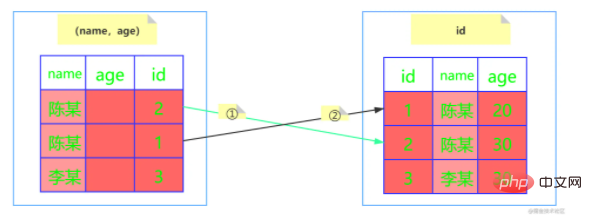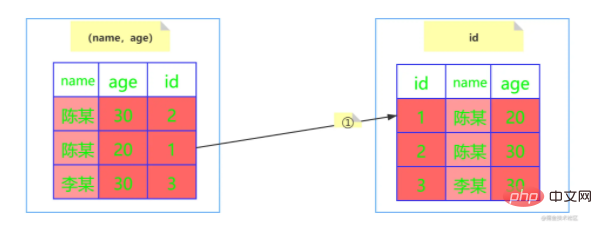Analyze what is Mysql index pushdown? Does it help optimization?
Mysql performance optimization: What is index pushdown?
Introduction
Index condition pushdown (index condition pushdown), referred to as ICP, was launched in the Mysql5.6 version and is used to optimize queries.
Without using ICP, when querying using a non-primary key index (also called a normal index or a secondary index), the storage engine retrieves the data through the index, and then returns it to the MySQL server, and the server then determines Whether the data meets the conditions.
When using ICP, if there are judgment conditions for certain indexed columns, the MySQL server will pass this part of the judgment conditions to the storage engine, and then the storage engine will judge whether the index meets the judgment conditions passed by the MySQL server. Conditions, only when the index meets the conditions will the data be retrieved and returned to the MySQL server.
Index condition pushdown optimization can reduce the number of times the storage engine queries the underlying table, and can also reduce the number of times the MySQL server receives data from the storage engine.
[Recommended learning: mysql video tutorial]
开游
Prepare a user table before starting (user), the main fields are: id, name, age, address. Create a joint index (name, age).
Suppose there is a requirement to match all users whose first name is Chen. The SQL statement is as follows:
SELECT * from user where name like '陈%'
According to the principle of "best left prefix", a joint index is used here ( name, age) is queried, and the performance is definitely higher than that of a full table scan.
The question is, what if there are other conditions? Suppose there is another requirement to match users whose first name is Chen and whose age is 20 years old. The SQL statement at this time is as follows:
SELECT * from user where name like '陈%' and age=20
How should this SQL statement be executed? The following is an analysis of versions before and after Mysql5.6.
Versions before Mysql5.6
Versions before 5.6 do not have the optimization of index pushdown, so the execution process is as follows:

will ignore the age field and query directly through name. Two results are found on the tree of (name, age). The ids are 2 and 1 respectively, and then take the obtained The id value is returned to the table for query again and again, so this process requires returning to the table twice.
Mysql5.6 and later versions
The 5.6 version adds the optimization of index pushdown. The execution process is as follows:

InnoDB does not ignore the age field, but determines whether age is equal to 20 within the index. Records that are not equal to 20 are skipped directly, so only matching is done in the (name, age) index tree. When a record is reached, take this ID and go back to the table in the primary key index tree to query all the data. This process only needs to go back to the table once.
Practice
Of course, the above analysis is only in principle, we can analyze it in practice, so Chen installed the Mysql5.6 version of Mysql and analyzed the above Statement, as shown below:

# According to the explain parsing results, it can be seen that the value of Extra is Using index condition, which means that index pushdown has been used.
Summary
The optimization of index pushdown on non-primary key indexes can effectively reduce the number of table returns and greatly improve query efficiency.
To turn off index pushdown, you can use the following command. The modification of the configuration file will not be described anymore. After all, why should such an excellent function be turned off:
set optimizer_switch='index_condition_pushdown=off';
The above is the detailed content of Analyze what is Mysql index pushdown? Does it help optimization?. For more information, please follow other related articles on the PHP Chinese website!

Hot AI Tools

Undresser.AI Undress
AI-powered app for creating realistic nude photos

AI Clothes Remover
Online AI tool for removing clothes from photos.

Undress AI Tool
Undress images for free

Clothoff.io
AI clothes remover

AI Hentai Generator
Generate AI Hentai for free.

Hot Article

Hot Tools

Notepad++7.3.1
Easy-to-use and free code editor

SublimeText3 Chinese version
Chinese version, very easy to use

Zend Studio 13.0.1
Powerful PHP integrated development environment

Dreamweaver CS6
Visual web development tools

SublimeText3 Mac version
God-level code editing software (SublimeText3)

Hot Topics
 1378
1378
 52
52
 MySQL: Simple Concepts for Easy Learning
Apr 10, 2025 am 09:29 AM
MySQL: Simple Concepts for Easy Learning
Apr 10, 2025 am 09:29 AM
MySQL is an open source relational database management system. 1) Create database and tables: Use the CREATEDATABASE and CREATETABLE commands. 2) Basic operations: INSERT, UPDATE, DELETE and SELECT. 3) Advanced operations: JOIN, subquery and transaction processing. 4) Debugging skills: Check syntax, data type and permissions. 5) Optimization suggestions: Use indexes, avoid SELECT* and use transactions.
 How to open phpmyadmin
Apr 10, 2025 pm 10:51 PM
How to open phpmyadmin
Apr 10, 2025 pm 10:51 PM
You can open phpMyAdmin through the following steps: 1. Log in to the website control panel; 2. Find and click the phpMyAdmin icon; 3. Enter MySQL credentials; 4. Click "Login".
 How to create navicat premium
Apr 09, 2025 am 07:09 AM
How to create navicat premium
Apr 09, 2025 am 07:09 AM
Create a database using Navicat Premium: Connect to the database server and enter the connection parameters. Right-click on the server and select Create Database. Enter the name of the new database and the specified character set and collation. Connect to the new database and create the table in the Object Browser. Right-click on the table and select Insert Data to insert the data.
 How to create a new connection to mysql in navicat
Apr 09, 2025 am 07:21 AM
How to create a new connection to mysql in navicat
Apr 09, 2025 am 07:21 AM
You can create a new MySQL connection in Navicat by following the steps: Open the application and select New Connection (Ctrl N). Select "MySQL" as the connection type. Enter the hostname/IP address, port, username, and password. (Optional) Configure advanced options. Save the connection and enter the connection name.
 MySQL and SQL: Essential Skills for Developers
Apr 10, 2025 am 09:30 AM
MySQL and SQL: Essential Skills for Developers
Apr 10, 2025 am 09:30 AM
MySQL and SQL are essential skills for developers. 1.MySQL is an open source relational database management system, and SQL is the standard language used to manage and operate databases. 2.MySQL supports multiple storage engines through efficient data storage and retrieval functions, and SQL completes complex data operations through simple statements. 3. Examples of usage include basic queries and advanced queries, such as filtering and sorting by condition. 4. Common errors include syntax errors and performance issues, which can be optimized by checking SQL statements and using EXPLAIN commands. 5. Performance optimization techniques include using indexes, avoiding full table scanning, optimizing JOIN operations and improving code readability.
 How to use single threaded redis
Apr 10, 2025 pm 07:12 PM
How to use single threaded redis
Apr 10, 2025 pm 07:12 PM
Redis uses a single threaded architecture to provide high performance, simplicity, and consistency. It utilizes I/O multiplexing, event loops, non-blocking I/O, and shared memory to improve concurrency, but with limitations of concurrency limitations, single point of failure, and unsuitable for write-intensive workloads.
 How to recover data after SQL deletes rows
Apr 09, 2025 pm 12:21 PM
How to recover data after SQL deletes rows
Apr 09, 2025 pm 12:21 PM
Recovering deleted rows directly from the database is usually impossible unless there is a backup or transaction rollback mechanism. Key point: Transaction rollback: Execute ROLLBACK before the transaction is committed to recover data. Backup: Regular backup of the database can be used to quickly restore data. Database snapshot: You can create a read-only copy of the database and restore the data after the data is deleted accidentally. Use DELETE statement with caution: Check the conditions carefully to avoid accidentally deleting data. Use the WHERE clause: explicitly specify the data to be deleted. Use the test environment: Test before performing a DELETE operation.
 MySQL: An Introduction to the World's Most Popular Database
Apr 12, 2025 am 12:18 AM
MySQL: An Introduction to the World's Most Popular Database
Apr 12, 2025 am 12:18 AM
MySQL is an open source relational database management system, mainly used to store and retrieve data quickly and reliably. Its working principle includes client requests, query resolution, execution of queries and return results. Examples of usage include creating tables, inserting and querying data, and advanced features such as JOIN operations. Common errors involve SQL syntax, data types, and permissions, and optimization suggestions include the use of indexes, optimized queries, and partitioning of tables.




